 |
||
|
Trekking Across Greece's Wild West By Penny Turner In the first article of a four-part series, Penny Turner sets off on amounted adventure across central Macedonia only to have her trusty steed,George, stolen at the first turn |
||
| Read first article,"Trekking Across Greece's Wild West." View entire second story,"An Adrenaline Rush." View entire third story, "A New Kind of Road Rage" View entire fourth story "How Not to go to Grammos" |
||
|
WHEN George and I set off from Katerini for Greece's Wild West (western Macedonia, it was just about spring, there was still plenty of snow on Olympus, the mountain sides were still frosty at midday), and the trees hadn't quite dared to come into leaf. For the first few days of a ride I normally walk a lot of the time to give George a chance to get used to being on the road again. I take the place of the boss mare - she who makes all the everyday decisions about herd life - to make him feel safer. He always feels a bit insecure at first, setting off for goodness knows where. |
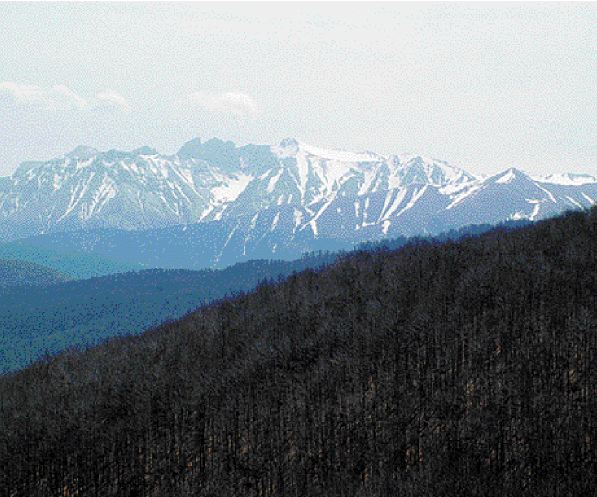 A glimpse of snowy Olympus in early spring with the mountain sides still frosty at midday |
|
|
I always mean to get fit before I go, but somehow I never do. So for a couple of days I get that fantastic adrenaline buzz and the euphoria brought on by the freezing mountain air, the gorgeous flowers, the feeling of freedom combined with the light-headedness brought on by going for the burn - there's nothing like it. But there is a downside.
This time it was the third morning that I woke up at dawn feeling as rotten as compost. The symptoms familiar from my five previous trips. A vile headache and acute nausea. I dizzily checked George: he was contentedly grazing and didn't want any water, so I ate a headache pill, got back in my sleeping bag and crashed in a brufen-induced stupor. I woke up later to find George gone. Not only gone, but gone wearing his bridle. Which he hadn't been wearing. |
||
| Stolen, that is to say. George's dusty hoofprints led down the road towards Velvendo. There were a few watery droppings on the road, George obviously nervous about leaving with this new friend. I ran as fast as my pounding head would allow down the hill towards Velvendo, the nearest village. I stopped a passing car. Had they seen a horse, a person with a horse, a big red horse? Yes they had. In the centre - you can't miss it, just keep straight on. I kept on running towards the village. I met an elderly lady with lapis lazuli eyes. "Is this the way to the centre?" "Yes." "Did you see anyone go by with a horse." "No, why?" "I lost my horse." |
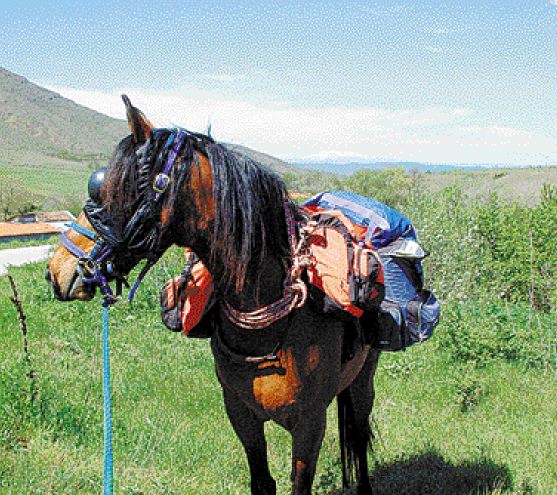 George in racing blinkers |
|
"Oh," she said, with an air of satisfaction, "he'll have been stolen. The people here are famous for stealing horses. Didn't you know that?" "Well no, actually." With a sinking heart I saw that George was indeed not in the centre. There was a taxi though. I got in it. I had to get to the nearest police station, which was at Servia. In my panic I hadn't thought to bring my passport for identification - first we had to go back to my camp to get it. I had left it with the rest of my valuables. My valuables! Aaaagh! On the seemingly endless journey (did I really run all that way with a headache and no coffee?) I told my troubles to the taxi driver. After a while he said laconically, "There's a red horse over there. Is that it?" George wasn't pleased to see me. He was tied in a very grassy field. The mystery as to who took him and why, and why they dumped him was actually solved later (find out 'who's done it' in the fourth and final part of the series). But at that moment all I cared about was that there he was, safe and sound. In the afternoon I gradually felt better. I pottered about looking at small-scale nature, I couldn't face anything very spectacular. |
||
I found a most remarkable insect crawling over a stone. If it had not been on dry land I would have thought it was a caddis fly larva. It was some kind of grub carrying its home, which it had made out of bits of dried grass. I had found one of these creatures once before, in the Mani, but it disappeared before I could photograph it. Even in my weakened state I was a match for this one, and photographed it from every angle. When I got home I looked it up everywhere. One book claims that it rejoices in the unromantic name of "bag worm". Others say it is a land caddis. Some authorities maintain that the members of the order Trichoptera (caddis flies) are exclusively aquatic, while other experts organise hunts in Wiltshire woodlands to find the rare, but obviously non aquatic land caddis. I choose to think of it as a bag worm. |
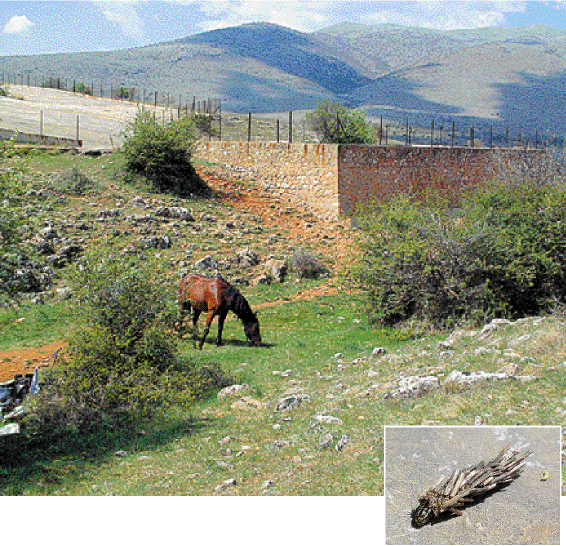 Lunch break at a manmade water hole on Aschio. Inset: A most unusual, unromantically named bag worm,or land caddis, according to others |
|
| In the evening I rode down to the village to see the celebrated church of Agios Nikolaos, which was the reason I had come to Velvendo at all. It is thoroughly painted inside and out - wherever a reasonably athletic person could possibly apply a brush and paint pictures of his favourite stories from Christian mythology. Some very kind ladies opened the church for me to see. All the precious icons have been stolen, some rumoured to be in Switzerland. To nick the frescoes, which would involve dismantling the entire building has proved, until now at least, beyond the capabilities of thieves, even those from a village that openly rejoices in its horse-stealing prowess. The ladies were sure God wouldn't mind me going in the church in my travelling gear, so I went inside. Fantastic. The next morning we set off early as we were going to have to cross the mountain to Servia, and we didn't want to get too hot on the steep uphill. This mountain is pretty wild. We got lost lots of times. The map says there is a track. Villagers and shepherds disagreed. But I was stubborn. And that's why, and Kala na pathe, as the villagers no doubt muttered, I found myself, after a lot of doubling back, dead ends, impassable river beds and so on scrambling up a rocky cliff face with George gamely following, grunting ostentatiously with the effort. |
||
| At the top we found ourselves in lovely meadows. And in one meadow was a perfect circular stone hut with a thatched roof. It was new. I went inside. It was being used as a barn. It was just like the huts they reconstruct so painstakingly for visitors to Stone Age sites. One of the sites listed in The Early Neolithic in Greece by Catherine Perles is Servia. She writes that most ancient villages in the area were built of mud bricks at that time, if there was mud. Otherwise they used materials that were to hand, like stones. So if anyone is thinking of building some Neolithic huts for a museum or something, let them go to Pieria, between Servia and Velvendo. There's someone up there who still knows how to do it. |
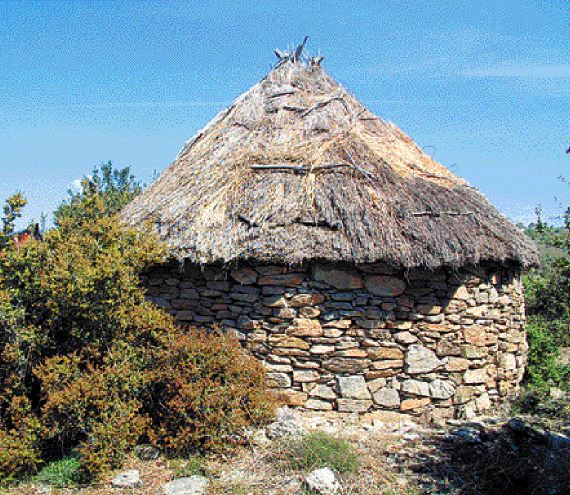 circular stone hut with a thatched roof |
|
| George and I got trapped on an asphalt road near Aeni because I couldn't find the track I was looking for. I velcroed George into some racing blinkers I had got for him. George is a city boy, having been brought up to be a carriage horse in Corfu town. He isn't afraid of traffic. He likes it. But he is afraid of plastic bags which can cause him to fling himself in terror into the path of a passing pantechnikon. Various villagers who have witnessed this suicidal behaviour have advised me to get blinkers for George. I agreed with the principle, but couldn't really think how to fix them until my friend Niko said, "What about those blinkers that racehorses wear?" Of course. So that's how George came to be wearing the rogue's badge as we struggled (calmly) along the asphalt towards Chromio. We got to Chromio as dusk was falling. Very often, if I have to stop near a village, I camp near the graveyard. There are very good reasons for this: |
||
| There is almost always water, because people need it for looking after graves. There is normally a lot of grass as shepherds and others don't feel comfortable in the environs of the graveyard, but the main reason is that no one at all feels comfortable there after dark. Experience has taught me that if there is a strange villager (the type who, for some reason, always seem to wear his trousers rather high at the ankle and insecurely fastened at the fly), then this person is the one who is attracted like a magnet by my arrival. But not even the most confused person in the village will ever come near the graveyard after dark. |
|
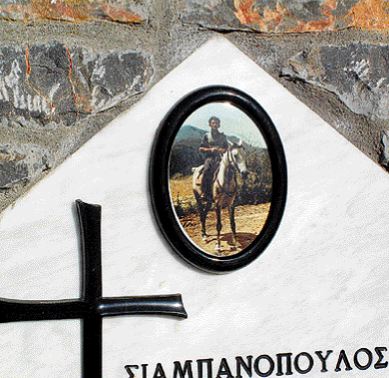 A horseman's grave with a photo of the handsome man sitting proudly on his horse |
|
So that's why I was at the graveyard in Chromio, and that's how I came to see the horseman's grave. It is the grave of Nikos Siampanopoulos. Nothing but his name and the date of his death, and his picture on the gravestone. There he is, a handsome man sitting proudly on his horse. And the horse is a beauty. I put some flowers there. I hope to meet him in Trapalanda, when my time comes. Actually, this part of Greece is a kind of Trapalanda. Greek horse heaven. |
||
| I would be riding along a quiet track when suddenly with a squeal of tires and a cloud of dust an ancient Mercedes would overtake me, jam on its brakes and, before I could even start to swear about him upsetting George, a great, fat, villainous-looking tough would have snatched up a photo from his dashboard, jumped out of the car and be flashing it under my nose. Not his girlfriend, not his kid... his horse! "Look! look!" he would say proudly while I struggled to find my glasses so I could pay proper attention, "That's my horse." He'd be stroking George and giving him a handful of raisins while I studied the photo, anxiously waiting for my approving comments, which were easy to give: lovely, tough, bold, characterful little chargers. |
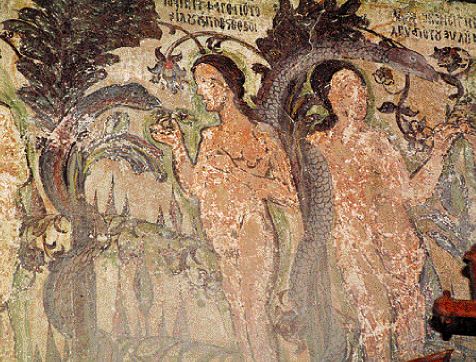 Frescoes of Adam and Eve in the church of Agios Nikolaos at the village of Velvendo |
|
|
I had never been to Siniatsicho, or Aschio, as the locals call it, but I had always been attracted by it. For years I had seen it every day as it looms huge over Nymphaeon where I used to live. It seemed a magical mountain, especially in winter. The snow would thaw on a warm day, and the water thus released would freeze at night, and so the mountain would seem to be made of glass. And this glass reflected the pink and red of the sunset and at night seemed to glow in the moonlight.
Above Siatista, the mountain is unbelievably barren, rocky and unwelcoming. No natural water at all. We stopped for lunch at a manmade water hole. A large area had been cemented over and made into a kind of giant funnel which directed rainwater into a huge tank. All the life of the area seemed to be concentrated in the damp area surrounding this place. Birds, butterflies, a small viper, flowers, grass for George. An oasis, no less. While I was eating my lunch I heard a tiny rustling in a bush beside me. At first I couldn't see the whole creature but only parts of a small lithe body with fur of the most soft and luxurious kind. Pale beige in colour. As it moved I saw the pure white of the belly fur. Close enough to touch. And how I wanted to touch it, to feel that unimaginable softness. It was a weasel, hunting. The god, Shredni Vashtar, himself. (To find out who Shredni Vashtar is, read the story of that name by "Saki".) I haven't seen anything more lovely than this perfect, bloodthirsty little predator. |
||
(Posting date 8 September 2006)
All articles of Athens News appearing on HCS have been reprinted with permission. |
||
|
||
|
2000 © Hellenic Communication Service, L.L.C. All Rights Reserved. http://www.HellenicComServe.com |
||

